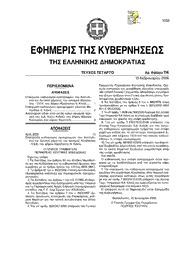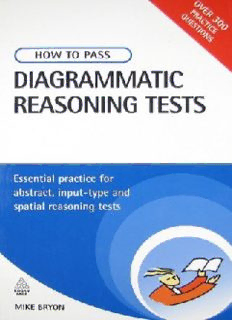
How to Pass Diagrammatic Reasoning Tests: Essential Practice for Abstract, Input Type and Spatial Reasoning Tests PDF
Preview How to Pass Diagrammatic Reasoning Tests: Essential Practice for Abstract, Input Type and Spatial Reasoning Tests
i HHOOWW TTOO PPAASSSS DIAGRAMMATIC REASONING TESTS ii THIS PAGE IS INTENTIONALLY LEFT BLANK iii iv Whilst the author has made every effort to ensure that the content of this book is accurate, please note that occasional errors can occur in books of this kind. If you suspect that an error has been made in any of the tests included in this book, please inform the publisher at the address printed below so that it can be corrected at the next reprint. Publisher’s note Every possible effort has been made to ensure that the information contained in this book is accurate at the time of going to press, and the publishers and author cannot accept responsibility for any errors or omissions, however caused. No responsibility for loss or damage occasioned to any person acting, or refraining from action, as a result of the material in this publication can be accepted by the editor, the publisher or the author. First published in Great Britain and the United States in 2008 by Kogan Page Limited Apart from any fair dealing for the purposes of research or private study, or criticism or review, as permitted under the Copyright, Designs and Patents Act 1988, this publication may only be reproduced, stored or transmitted, in any form or by any means, with the prior permission in writing of the publishers, or in the case of reprographic reproduction in accordance with the terms and licences issued by the CLA. Enquiries concerning repro- duction outside these terms should be sent to the publishers at the undermentioned addresses: 120 Pentonville Road 525 South 4th Street, #241 London N1 9JN Philadelphia PA 19147 United Kingdom USA www.koganpage.com © Mike Bryon, 2008 The right of Mike Bryon to be identified as the author of this work has been asserted by him in accordance with the Copyright, Designs and Patents Act 1988. ISBN 978 0 7494 4971 1 British Library Cataloguing-in-Publication Data A CIP record for this book is available from the British Library. Library of Congress Cataloging-in-Publication Data Bryon, Mike. How to pass diagrammatic reasoning tests : essential practice for abstract, input type and spacial reasoning tests / Mike Bryon. p. cm. ISBN 978-0-7494-4971-1 1. Reasoning (Psychology)--Testing. I. Title. BF442.B79 2008 153.4(cid:2)3--dc22 2008027145 Typeset by Saxon Graphics Ltd, Derby Printed and bound in India by Replika Press Pvt Ltd v Contents Acknowledgements vi 1 A unique source of essential practice 1 Start by getting test wise 2; Adopt a winning mindset 3; Devise and implement an unbeatable study plan 4; What to expect on the day 7; Aim to make a really good start and to keep going 9; Guessing can pay 9; If you suffer a disability 9; How to use this book 10; What to do if you fail 11 2 Abstract reasoning tests 13 Style one 14; Style two 20; Style three 33; Style four 45; Four mini-tests 59 3 Input-type diagrammatic reasoning tests 71 Type 1 72; Type 2 76; Type 3 83; Type 4 87; Twelve mini-tests 95 4 Conceptual or spatial reasoning tests 134 Type 1 135; Type 2 141; Type 3 146; Type 4 152; Type 5 158; Ten mini-tests 165 5 Answers and explanations 196 Chapter 2 Abstract reasoning 196; Chapter 3 Input- type diagrammatic reasoning 212; Chapter 4 Conceptual/spatial reasoning 220 vi Acknowledgements I owe thanks to Anabel Gelhaar and Andrea Zigon for devising and drawing the conceptual/spatial reasoning questions in Chapter 4. 1 1 A unique source of essential practice Diagrammatic reasoning tests involve a series of pictorial or diagrammatic questions with little or no resort to words or numbers. Some require you to undertake highly complex trans- formations or manipulations of awkward shapes all in your head against a tight timescale (see Chapter 4). Others involve shapes or letters that apply rules. You may have to reverse a sequence of letters or shapes, or drop or add letters or shapes, and so on. Again you must complete these tasks against a tight time constraint (see Chapter 3). Another style of question requires you to identify features in common to complete a series or choose an answer that correctly completes a series of shapes from a number of suggestions (see Chapter 2). You will not find another book that provides practice for all three of these, the most common types of diagrammatic reasoning tests. If you have to pass a diagrammatic reasoning test or never seem to do well in them, if you have been searching for a source of practice or have found it hard to get sufficient practice material, then this is the book for you. You can learn to master these common assessments and become more confident and accurate in every sort of diagrammatic reasoning test. This book provides everything you need for a successful programme of revision or review and for many candidates will mean the difference between 2 How to pass diagrammatic reasoning tests pass and fail. It contains over 300 practice questions, with answers and explanations and advice on how to show your true potential. You will not find another book on this subject with so many practice questions. Uniquely it also offers 26 timed mini- tests so you can develop the all-important speed at answering these questions and approach a real test with a new confidence. Tests of diagrammatic reasoning feature in the recruitment process for many positions, including for example professional services, finance, accountancy, graduate traineeships, architecture, engineering and even the UKCAT (the test you must pass in order to win a place at medical school). Such a test is likely to be one of a number of sub-tests that make up the assessment. Commonly the assessment will include a test of verbal and numerical reasoning as well as a test of diagrammatic reasoning. You take these sub-tests one after the other, online at a computer or with paper and pen. It is important that you realize that you are likely to be one of a large number of candidates, and you must achieve a score better than the majority in order to pass through to the next stage in the recruitment process. You may also have to achieve a well-balanced score across a number of sub-tests. Doing well in these common assessments is largely down to practice of the right sort, the right amount, at the right time. Success in any psychometric test often requires hard work, time and commitment. The choice is entirely yours. If you rise to the challenge, your dream career could become a reality. The alter- native is to risk failure. Start by getting test wise It is really important that you understand exactly what the test you face involves. You will be astonished at how many people attend a test not knowing what to expect. The first time they learn of the type of questions involved is when the test administrator describes them just before the test begins. Don’t make this mistake. You need to know the nature of the challenge as soon as possible. A unique source of essential practice 3 The organization to which you have applied should have sent you a description of the type of questions and the format with the letter or e-mail of invitation. If they have not done this then have a look on their website or contact them and ask them to describe the test. Be sure to get details on: (cid:2) how many sub-tests the test battery comprises; (cid:2) what the title of each sub-test is; (cid:2) what sort of question makes up a sub-test (you should be provided with, or directed to, a description of each type of question); (cid:2) how many questions each sub-test includes; (cid:2) how long you have to complete each sub-test; (cid:2) whether it is multiple-choice or short-answer; (cid:2) whether you complete it with pen and paper or at a computer terminal; (cid:2) if you face a numeracy test, whether or not a calculator is allowed. Adopt a winning mindset It is common to experience feelings of irritation or resentment about having to sit a test. It is crucial that you put these feeling aside. They can be very counterproductive. Try not to wonder about the validity of the test. What you think of it and its predictive value is entirely irrelevant. You need to do well in this test if you are to realize your goal. Focus on only that goal and for a few weeks put all else aside. You really need to let your determi- nation to do well take over your life for a while. Some very clever and highly educated people do not do well at these tests. In some cases their training and inclination do not serve them well under the rather artificial conditions of a timed test. This happens when, for example, the candidate thinks too deeply about the question or studies the questions too carefully. Some place too high an emphasis on accuracy at the expense of speed. The outcome is that their test result does not reflect their
Description:The list of books you might like

Can’t Hurt Me: Master Your Mind and Defy the Odds

The 5 Second Rule: Transform your Life, Work, and Confidence with Everyday Courage

The 48 Laws of Power

$100m Offers

Israeli-Turkish Tensions and their International Ramifications
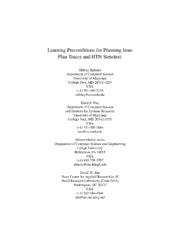
DTIC ADA448060: Learning Preconditions for Planning from Plan Traces and HTN Structure

Cisne blanco

Solanum tergosericeum (Solanaceae: sect. Basarthrum): a new species from Peru

Punto, linea, superficie

COMESA 273: Textile fibres - Determination of breaking force and elongation at break of individual fibres

COMESA 265-1: Textiles — Burning behaviour of bedding items —Part 1:General test methods for the ignitability by a smouldering cigarette

ERIC EJ1069138: Taking a Closer Look at Reading Online

Slaves of Socorro

ALTO 2017
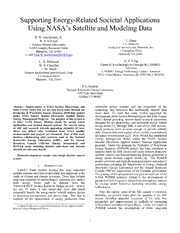
Supporting Energy-Related Societal Applications Using NASA's Satellite and Modeling Data

Fire Caste
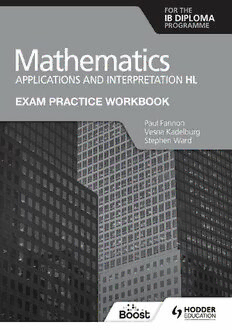
Exam Practice Workbook for Mathematics for the IB Diploma: Applications and interpretation HL

Electromagnetismo I

NASA Technical Reports Server (NTRS) 20080006488: Optically Thin Liquid Water Clouds: Their Importance and Our Challenge

A new species of Oncocephalus (Heteroptera, Reduviidae, Stenopodainae) from Japan

Éléments essentiels du programme d'adaptation scolaire destiné aux élèves aveugles ou ayant des déficiences visuelles
